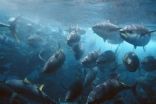(Press-News.org) Marine zoning in the Pacific Ocean, in combination with other measures, could significantly improve numbers of heavily overfished bigeye tuna and improve local economies, a fish modelling study has found.
Scientists working at the University of Hawaii at Manoa (Honolulu, HI), the Secretariat of the Pacific Community (SPC, Noumea, New Caledonia) and Collecte Localisation Satellites (CLS, Toulouse, France), have found that a network of marine zones in the Pacific Ocean could be a more effective conservation measure than simply closing relatively small areas to some types of fishing.
These marine zones, where different fishing activities are allowed in different areas, may have significant and widespread benefits for bigeye tuna numbers.
Dr John Sibert of the University of Hawaii Joint Institute of Marine and Atmospheric Research is one of four scientists leading the study.
After testing the effectiveness of a range of conservation measures with an ecosystem and fish population model, Dr Sibert says the team found that the most effective measures were to:
restrict longline fishing in tuna-spawning areas
manage the use of fish-aggregating devices (e.g. moored or drifting buoys which attract fish) in purse-seine areas.
"We found that simply closing areas off to fishing doesn't work, because the boats just move their operations to neighbouring zones and fish even harder. It's going to need a combination of approaches," he says.
"The model will help people evaluate alternative policies to manage tropical tuna fisheries. Our predictions can help countries estimate how effective conservation measures might be, relative to any economic effects, and tailor measures to suit their goals. The advantage of this approach is that effects can be estimated locally, as well as for the stock as a whole."
Half the current bigeye tuna catch is by longline, which targets high-value tuna sold as fresh fish. These fish command a market premium and sell for over $10 per kilogram.
The other half is caught in purse-seine nets as incidental bycatch when aiming to catch skipjack tuna. These juvenile bigeye tuna are sold to the canning industry for $1.70 per kilogram.
Dr Sibert says the study calls for a complete economic valuation of the Western Central Pacific Ocean (WCPO) tuna fishery.
He says the most effective conservation measures are those "which protect fish throughout their lifetime."
Rebuilding the bigeye-tuna stock will take at least 15 years, and will be affected by any climate changes the ecosystems experience.
INFORMATION:
The Spatial Ecosystem and Population Dynamics Model (SEAPODYM) used in the analysis was developed with support from a series of European Union–funded projects implemented by the Oceanic Fisheries Programme of the SPC, the NOAA-funded Pelagic Fisheries Research Program at the University of Hawaii and CLS.
Sibert, J., I. Senina, P. Lehodey, and J. Hampton. 2012. Shifting from marine reserves to maritime zoning for conservation of Pacific bigeye tuna (Thunnus obesus). PNAS 109(44): 18221.
For more information:
Pelagic Fisheries Research Program (PFRP): http://www.soest.hawaii.edu/PFRP/
The Secretariat of the Pacific Community (SPC): http://www.spc.int/en/
Collecte Localisation Satellites (CLS), a subsidiary of CNES (French Space Agency) and IFREMER (French Research Institute for exploration of the sea): http://www.cls.fr/welcome_en.html
The Spatial Ecosystem and Population Dynamics Model (SEAPODYM) model: http://www.spc.int/OceanFish/en/ofpsection/ema/ecosystem-a-multispecies-modelling/seapodym/148-seapodym
Pacific fishing zones -- lifeline for overfished tuna?
2012-11-14
ELSE PRESS RELEASES FROM THIS DATE:
PNNL expertise highlighted at Supercomputing
2012-11-14
From identifying common patterns in data to speeding up computers, researchers from the Department of Energy's Pacific Northwest National Laboratory will share their computational expertise at this year's Supercomputing conference.
Also referred to as SC 12, the annual gathering is the international conference for high-performance computing, networking, storage and analysis. It runs Nov. 10-16 at the Salt Palace Convention Center in Salt Lake City. Two noteworthy talks featuring PNNL research are described below.
New algorithm pin-points similar data in seconds
Data ...
Computer science helping the aged stay home
2012-11-14
University of Adelaide computer scientists are leading a project to develop novel sensor systems to help older people keep living independently and safely in their own homes.
The researchers are adapting radio-frequency identification (RFID) and sensor technologies to automatically identify and monitor human activity; to be able to determine if an individual's normal routine is being maintained so that timely assistance can be provided if it is needed.
Although RFID technology has been around since World War 2 and is in common use today in applications such as anti-shoplifting ...
Preserve the services of mangroves -- Earth's invaluable coastal forests, experts urge
2012-11-14
Experts are urging policy makers to preserve mangroves and their essential services to nature and humanity alike, saying their replacement with shrimp farms and other forms of development is a bad economic tradeoff both short and long-term.
An unprecedented partnership of organizations – from forestry and conservation sectors and from across the United Nations – have released a policy brief drawing on the 2nd edition of the World Atlas of Mangroves (2010). It aims to provide managers with lessons learned in past mangrove conservation and management efforts, and with policy ...
The leggiest animal on Earth lives in the outskirts of Silicon Valley
2012-11-14
The leggiest animal in the world, the millipede lllacme plenipes, was re-discovered several years ago in California by Paul Marek. Now, Marek and his colleagues provide further details of the surprisingly complex anatomy of this diminutive creature and its extreme rarity, limited to a handful of spots just south of San Francisco. More details about the species and its biology can be read in an article that was recently published in the open access journal ZooKeys.
Millipedes have the most legs of any animal group. From their ancestors with just one pair of legs per body ...
Lost in space: Rogue planet spotted?
2012-11-14
Astronomers using ESO's Very Large Telescope and the Canada-France-Hawaii Telescope have identified a body that is very probably a planet wandering through space without a parent star. This is the most exciting free-floating planet candidate so far and the closest such object to the Solar System at a distance of about 100 light-years. Its comparative proximity, and the absence of a bright star very close to it, has allowed the team to study its atmosphere in great detail. This object also gives astronomers a preview of the exoplanets that future instruments aim to image ...
Astronomers find 'homeless' planet wandering through space
2012-11-14
A planet that is not orbiting a star, effectively making it homeless, has been discovered by a team of University of Montreal (UdeM) researchers working with European colleagues and data provided by the Canada-France-Hawaii Telescope (CFHT) and the European Southern Observatory's Very Large Telescope (VLT). "Although theorists had established the existence of this type of very cold and young planet, one had never been observed until today," said Étienne Artigau, an astrophysicist at UdeM. The absence of a shining star in the vicinity of this planet enabled the team to study ...
Georgia Tech releases cyber threats forecast for 2013
2012-11-14
The year ahead will feature new and increasingly sophisticated means to capture and exploit user data, escalating battles over the control of online information and continuous threats to the U.S. supply chain from global sources. Those were the findings made by the Georgia Tech Information Security Center (GTISC) and the Georgia Tech Research Institute (GTRI) in today's release of the Georgia Tech Emerging Cyber Threats Report for 2013. The report was released at the annual Georgia Tech Cyber Security Summit, a gathering of industry and academic leaders who have distinguished ...
Pancreas stem cell discovery may lead to new diabetes treatments
2012-11-14
Stem cells in the adult pancreas have been identified that can be turned into insulin producing cells, a finding that means people with type 1 diabetes might one day be able to regenerate their own insulin-producing cells.
The discovery was made by scientists from the Walter and Eliza Hall Institute and provides further evidence that stem cells don't only occur in the embryo.
The ability to produce the hormone insulin is crucial for controlling blood sugar (glucose) levels. In people with type 1 diabetes the body's immune system destroys the insulin-producing beta cells ...
Antibody-coated stents: Indication of disadvantages
2012-11-14
If narrowed or blocked coronary vessels have to be widened or opened, a vascular support (stent) is usually inserted. Drug-coated stents are preferred for patients at high risk of renewed narrowing of vessels (restenosis). However, the use of antibody-coated stents has been increasing in recent years. Current studies provide indications that these new antibody-coated stents more frequently lead to myocardial infarction and make re-operation necessary. This is the conclusion reached in the rapid report of the German Institute for Quality and Efficiency in Health Care (IQWiG), ...
'Missing link' discovered in the defence mechanism of the tuberculosis pathogen
2012-11-14
Brussels, 14 November 2012 – Flemish biologists lead by Joris Messens (VIB / Vrije Universiteit Brussel) have discovered that Mycobacterium tuberculosis – the bacterium that causes tuberculosis – has an ingenious defence mechanism against oxygen. This knowledge is important in the search for a treatment for tuberculosis. 9.4 million people are infected with tuberculosis annually and 1.7 million people die as a result.
Joris Messens: "We have discovered how Mycobacterium survives the oxygen stress in our body, namely with the aid of the protein mycoredoxin-1. This opens ...





